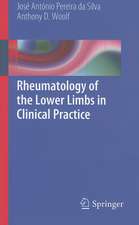Ankylosing spondylitis and Klebsiella
Autor Alan Ebringeren Limba Engleză Paperback – 23 aug 2016
When a patient is infected by Klebsiella bacteria, his or her immune system will make antibodies against all the antigens or molecules found in the microbe. Because some of the bacterial antigens resemble self tissues, the anti-bacterial antibodies will attack not only the bacteria but also the self tissues such as the joints and the cells having the same HLA molecules, which is how the disease AS starts. This is the concept of molecular similarity or “molecular mimicry” which previously has been found to work in two other autoimmune diseases; rheumatic fever and rheumatoid arthritis.
The first paper on this subject was published in 1976 and sincethen over 100 papers on rheumatological topics have been published, from Prof Ebringer’s group, at the Division of Life Sciences, King’s College in London, UK.
The relevant information from these papers is extracted and presented in this book format making it accessible to health professionals, research institutions, pharmaceutical companies and universities and the general public.
| Toate formatele și edițiile | Preț | Express |
|---|---|---|
| Paperback (1) | 1088.99 lei 38-44 zile | |
| SPRINGER LONDON – 23 aug 2016 | 1088.99 lei 38-44 zile | |
| Hardback (1) | 1503.87 lei 6-8 săpt. | |
| SPRINGER LONDON – 6 noi 2012 | 1503.87 lei 6-8 săpt. |
Preț: 1088.99 lei
Preț vechi: 1146.31 lei
-5% Nou
Puncte Express: 1633
Preț estimativ în valută:
208.44€ • 226.49$ • 175.21£
208.44€ • 226.49$ • 175.21£
Carte tipărită la comandă
Livrare economică 18-24 aprilie
Preluare comenzi: 021 569.72.76
Specificații
ISBN-13: 9781447172048
ISBN-10: 1447172043
Pagini: 256
Ilustrații: XX, 256 p.
Dimensiuni: 155 x 235 mm
Greutate: 4.72 kg
Ediția:Softcover reprint of the original 1st ed. 2013
Editura: SPRINGER LONDON
Colecția Springer
Locul publicării:London, United Kingdom
ISBN-10: 1447172043
Pagini: 256
Ilustrații: XX, 256 p.
Dimensiuni: 155 x 235 mm
Greutate: 4.72 kg
Ediția:Softcover reprint of the original 1st ed. 2013
Editura: SPRINGER LONDON
Colecția Springer
Locul publicării:London, United Kingdom
Cuprins
Ankylosing spondylitis as a scientific problem.- History of the origin of ankylosing spondylitis.- The discovery of HLA-B27 in ankylosing spondylitis and related disorders.- Molecular mimicry between HLA-B27 and Klebsiella bacteria investigated by using rabbit antisera.- Molecular mimicry between HLA-B27 and Klebsiella bacteria investigated by using human tissue typing sera.- Muscle changes in ankylosing spondylitis.- Raised serum IgA is present in ankylosing spondylitis patients.- Faecal cultures in ankylosing spondylitis and uveitis.- Biochemical parameters and Klebsiella in ankylosing spondylitis.- Binding of Klebsiella antisera to HLA-B27 cells.- IgA antibodies to Klebsiella and other Gram-negative bacteria in ankylosing spondylitis.- IgA antibodies to Klebsiella measured by immunoblotting.- Antibodies to Klebsiella in ankylosing spondylitis measured by bacterial agglutination and ELISA against lipopolysaccharides.- Dutch and German patients with ankylosing spondylitis have antibodies to Klebsiella.- Spanish, Finnish and Swedish patients with ankylosing spondylitis have antibodies to Klebsiella.- Molecular mimicry between Klebsiella pullulanase enzyme, HLA-B27 and collagens I and IV.- Antibodies to Klebsiella and HLA-B27 peptides in ankylosing spondylitis patients from southern Japan.- Ankylosing spondylitis sera are cytotoxic to cells bearing HLA-B27 sequences.- Pathogenesis of ankylosing spondylitis and Klebsiella substrates.- Ankylosing spondylitis and the “low starch diet”.- The problem of Crohn’s disease and Klebsiella.- Ankylosing spondylitis and “Popper sequences”.
Textul de pe ultima copertă
Ankylosing spondylitis and Klebsiella is a comprehensive and informative text on the cause of Ankylosing spondylitis. Ankylosing spondylitis (AS) is a condition which affects 20 million people worldwide and is likely caused or initiated by a bowel infection from Klebsiella bacteria.
When a patient is infected by Klebsiella bacteria, his or her immune system will make antibodies against all the antigens or molecules found in the microbe. Because some of the bacterial antigens resemble self tissues, the anti-bacterial antibodies will attack not only the bacteria but also the self tissues such as the joints and the cells having the same HLA molecules, which is how the disease AS starts. This is the concept of molecular similarity or “molecular mimicry” which previously has been found to work in two other autoimmune diseases; rheumatic fever and rheumatoid arthritis.
The first paper on this subject was published in 1976 and since then over 100 papers on rheumatological topics have been published, from Prof Ebringer’s group, at the Division of Life Sciences, King’s College in London, UK.
The relevant information from these papers is extracted and presented in this book format making it accessible to health professionals, research institutions, pharmaceutical companies and universities and the general public.
When a patient is infected by Klebsiella bacteria, his or her immune system will make antibodies against all the antigens or molecules found in the microbe. Because some of the bacterial antigens resemble self tissues, the anti-bacterial antibodies will attack not only the bacteria but also the self tissues such as the joints and the cells having the same HLA molecules, which is how the disease AS starts. This is the concept of molecular similarity or “molecular mimicry” which previously has been found to work in two other autoimmune diseases; rheumatic fever and rheumatoid arthritis.
The first paper on this subject was published in 1976 and since then over 100 papers on rheumatological topics have been published, from Prof Ebringer’s group, at the Division of Life Sciences, King’s College in London, UK.
The relevant information from these papers is extracted and presented in this book format making it accessible to health professionals, research institutions, pharmaceutical companies and universities and the general public.
Caracteristici
Ankylosing spondylitis and Klebsiella is a handy and informative text on the cause of Ankylosing spondylitis Contains full color illustrations and depicts the microbe Klebsiella’s action on the body Ankylosing spondylitis and Klebsiella is a valuable information resource which contains all of the latest research on the subject making it accessible to patients, research institutions, pharmaceutical firms, universities, health professionals and the general public Contains descriptions of antibodies to Klebsiella in AS patients from 15 different countries Includes supplementary material: sn.pub/extras
















